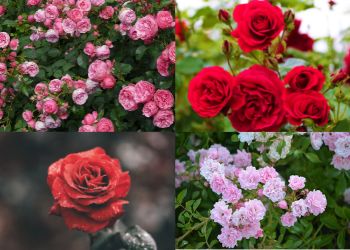Roses are extremely popular garden plants and are so beautiful to look at. They provide a classic elegant and prestigious garden look. But what types of roses would suit your needs? What are the differences between the various types?
What I’ve learned over a few years of growing roses is what I’m going to discuss here …to the best of my knowledge.
Let’s start with a list of the categories. To most this may mean very little, so we’ll get into a bit more overview on each one and provide some thoughts on how they might suit your rose desires!
Types of roses – Main categories 🌹
The types of roses – with all their cultivars – run into the thousands, and like many plants, some of the original versions have long been forgotten (mostly).
The world is now filled with a plethora of hybridized roses. So much so that it can be difficult to know what categories any of them fall into!
But when you look at a rose, some giveaways help you determine its original type. Here are the main types of roses as a list to start with:
- Floribunda rose
- Grandiflora rose
- Hybrid Tea rose
- Polyantha rose
- Miniature rose and Miniflora rose
- Shrub rose
- Climber and Rambler rose
- Rose Tree
This is further compounded by whether they are an Old Garden Rose, a modern garden rose, or a wild (species) rose. More on those rose categories here.
But the trick is not to get too hung up on the species – trust me – unless you’re an uber gardening geek it’s not worth your time.
Simply identify some main characteristics of each of the varieties. So you know roughly what to look for …and therefore what will suit your given situation. And of course, take note of the growing zones when buying and planting roses.
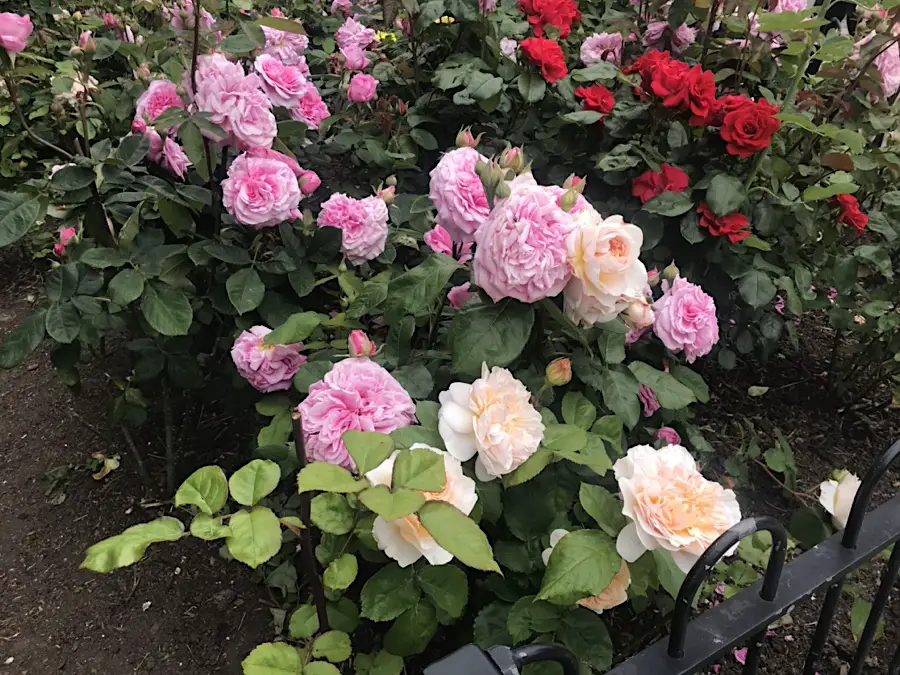
Types of roses – Lists may vary
If there’s one thing I have come to understand, it’s that the list may vary. For example, some sources have a category for landscape roses, but to some, these are simply shrub roses. So take this list as a general overview of the types of roses that you’re likely to see.
Let’s discuss the types in more detail…
Floribunda Roses
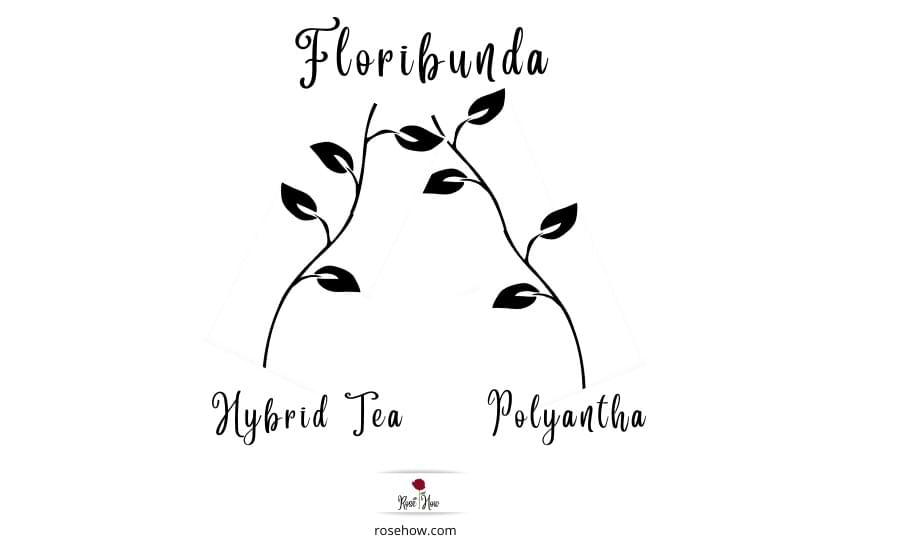
A “modern garden rose”. These types of roses are similar to hybrid tea roses, in that they have large, full flowers. But what sets them apart is that they bloom in clusters, giving them a fuller appearance. Sometimes with up to 50 petals. And because of these reasons, they make for excellent garden roses.
They are more compact than hybrid teas but taller and more robust than polyanthas.
Floribundas are available in a wide range of colors, from classic red to white, pink, orange, yellow, and some blends.
Floribundas are generally repeating bloomers, meaning they will bloom multiple times throughout the season. You can expect a Spring and Summer bloom, and possibly a Fall bloom, or sporadic blooms at other times.
They have a general height of 2-4 feet and a spread of 2-4 feet. But can grow as big as 6 feet wide, and 8 feet tall.
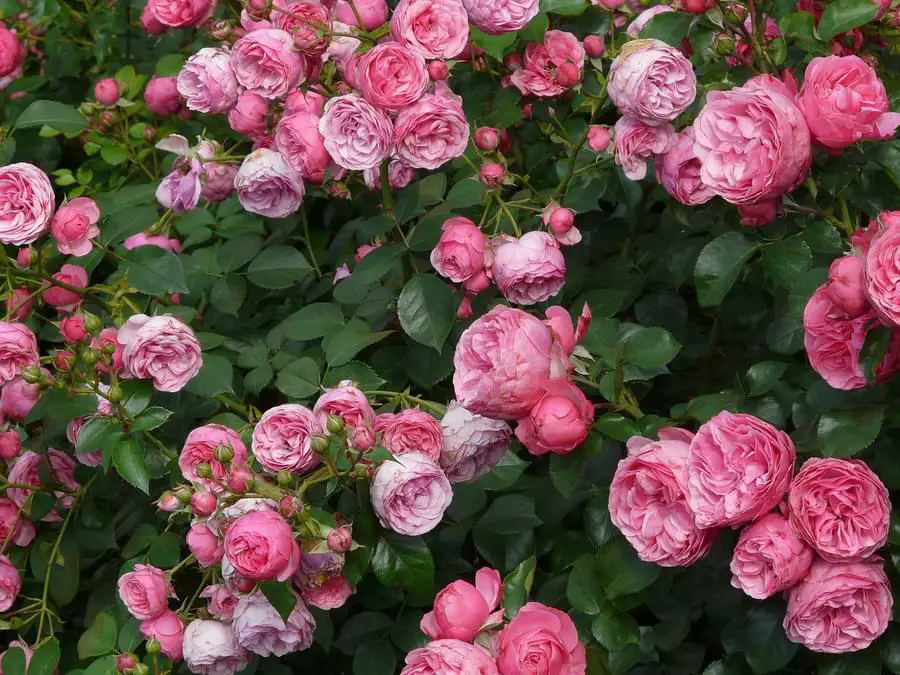
They are also generally disease-resistant for most varieties. And in terms of maintenance, are relatively easy to care for.
Floribundas are ideal for garden beds, borders, and mass plantings.
They bloom in Spring and Summer, but in gardens, they often provide color from Spring until Fall because they can produce several blooms.
Floribunda Rose Main Characteristics
- Type: Modern Garden Rose
- Bush size: 3′ – 8′
- Flower Size: Around 3 ½ – 5 inches across
- Petal Number: Averaging 20-30, maximum of around 50
- Flower Color: Red, white, pink, orange, yellow, lavender, and other blends
- Flowering: Repeating waves of flowers
- Stem: Singular or in clusters; some can be used as cut flowers
- Fragrance: Fragrances tend to vary from medium to strong
- Disease Resistance: Some offer excellent disease resistance, a few can be susceptible to black spot disease, or powdery mildew
- Hardiness: Zones 4+. Most are within zones 5 to 9
If you’re looking for a rose bush that will produce an abundance of beautiful blooms, then a Floribunda rose is likely to be the right choice for you.
If floribunda sounds like the rose for you, then head over to shop a range of floribunda roses.
For a full rundown on Floribunda roses, see my article outlining much more about Floribunda roses. Including characteristics, uses, and care.
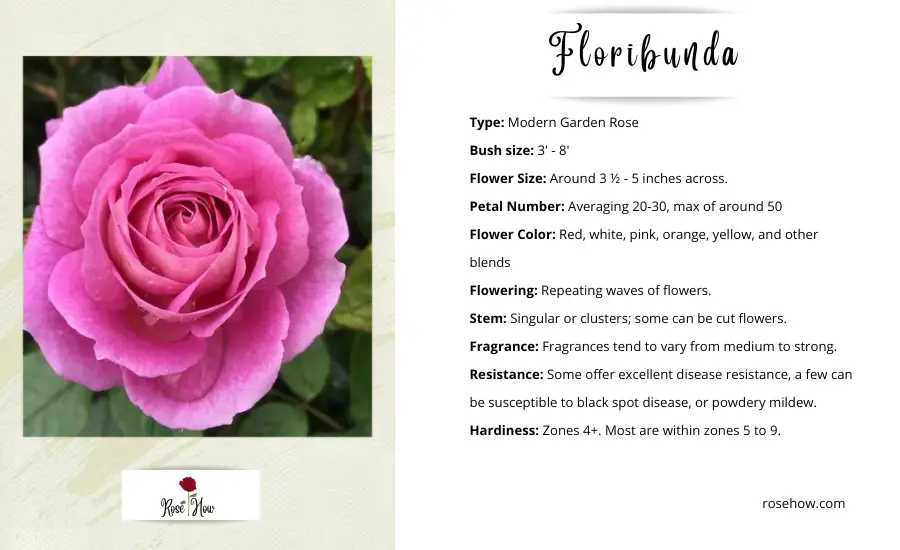
Grandiflora Roses
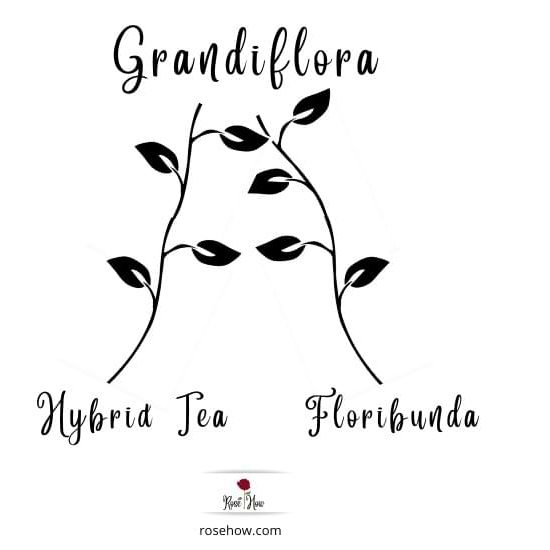
These types of roses are a cross between hybrid tea and floribunda roses. They were first bred in 1867, although some argue as far back as the 50s.
Their main aim was to produce a rose bush that flowered more abundantly than the hybrid tea, with blooms that were larger than those of floribunda roses.
And they succeeded! Grandifloras are well known for their large clusters of flowers which appear in succession throughout the flowering season. They also have a long vase life,
So, they have the best qualities of both types – large, full flowers like hybrid teas, but also bloom in clusters like floribundas.
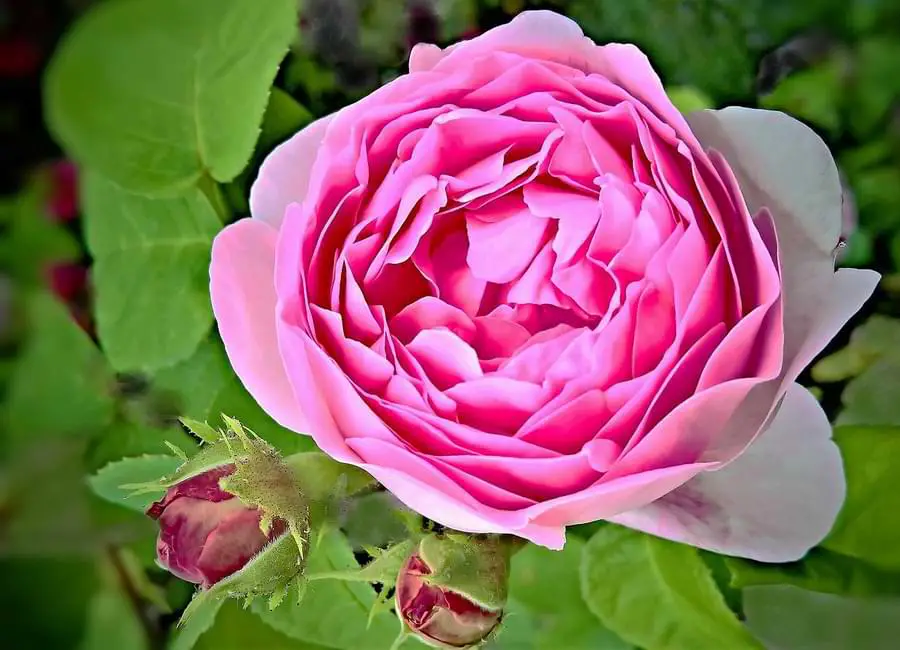
Their large flowers can sometimes be as large as dining spanning 8″-12″, with anything from 30 to 40 petals.
But what sets them apart is that they have a longer stem, which makes them ideal for cutting and using in arrangements.
Grandifloras have flowers that are larger and less numerous than floribundas but that are smaller and more plentiful than hybrid teas.
In terms of size, grandiflora bushes are generally taller than other types of garden roses too, making them ideal for growing as a rose hedge.
Grandiflora roses are also repeated bloomers, and will often produce several flushes of flowers throughout the growing season.
In terms of size, Grandiflora roses are somewhere between Hybrid Tea and Floribunda roses.
Grandifloras are also known for their strong, pleasant fragrance.
Grandiflora Rose – Main Characteristics
- Type: Modern Garden Rose
- Bush size: Medium to large
- Flower size: 8 – 12 inches across
- Petal Number: 30 – 40
- Flower color: colors are variable, but many are shades of pink
- Flowering: Repeating waves of flowers throughout the season
- Stem: Dark green, tall, singular, thorny
- Fragrance: Strong and pleasant
- Disease Resistance: Moderately resistant to most diseases
- Hardiness: Ideal for zones 5 – 9, but can grow in zones 4-10
If Grandiflora sounds like your kind of rose, then go over to shop a range of grandiflora roses.
For a full rundown on Grandiflora roses, see my article outlining much more about Grandiflora roses, including their characteristics, uses, and care.
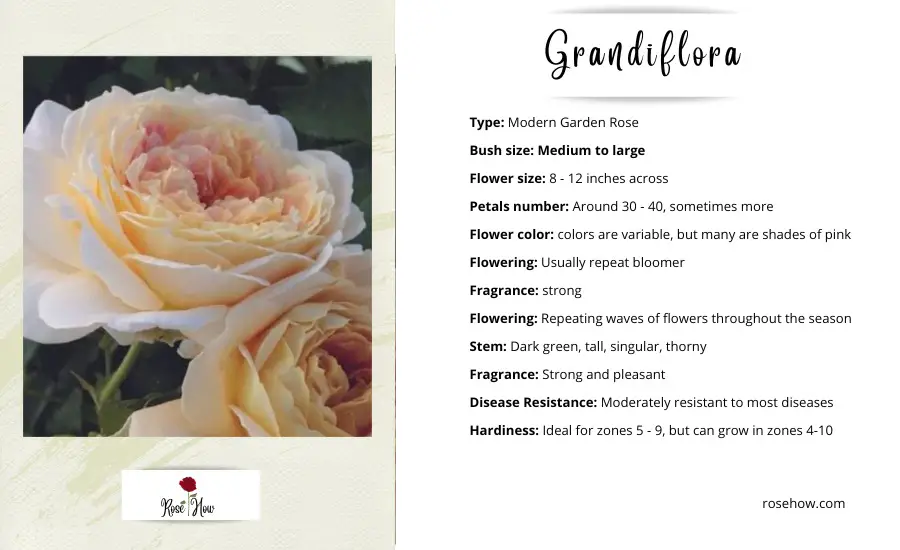
The next type of rose on the list is the Hybrid Tea rose.
Hybrid Tea Roses
Hybrid tea roses are probably the type of rose that most people think of when they hear the word “rose”.
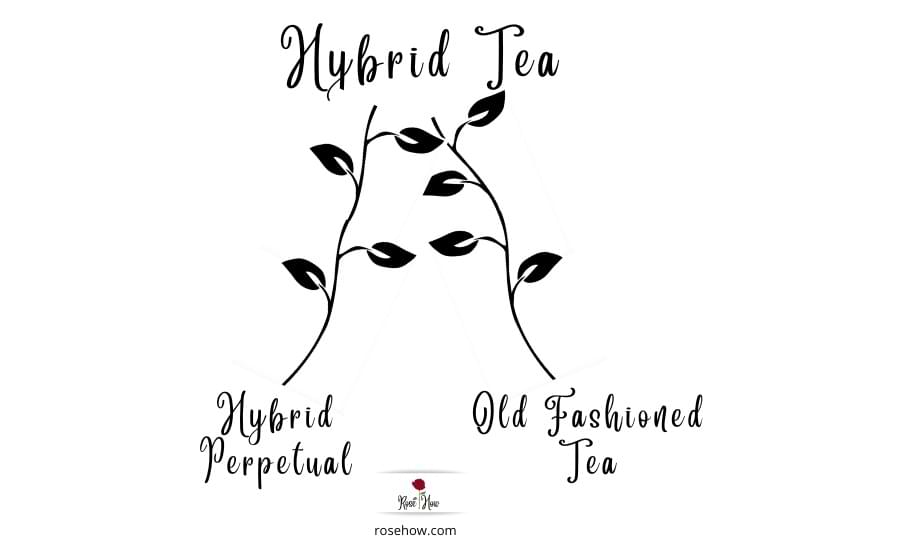
Hybrid tea roses are a cross between two types of roses, usually, a hybrid perpetual rose, and an old-fashioned tea rose.
Varieties of hybrid tea roses are often produced as the quintessential Valentine’s rose.
They are best known for their medium, well-formed flowers that are around 3-5 inches. And blooming singularly on long stems. Bushes can grow between 2 and 8 feet in size.
Hybrid tea roses come in a wide range of colors, from the classic red rose to yellow, pink, and white. They can be so crimson red as to almost be black.
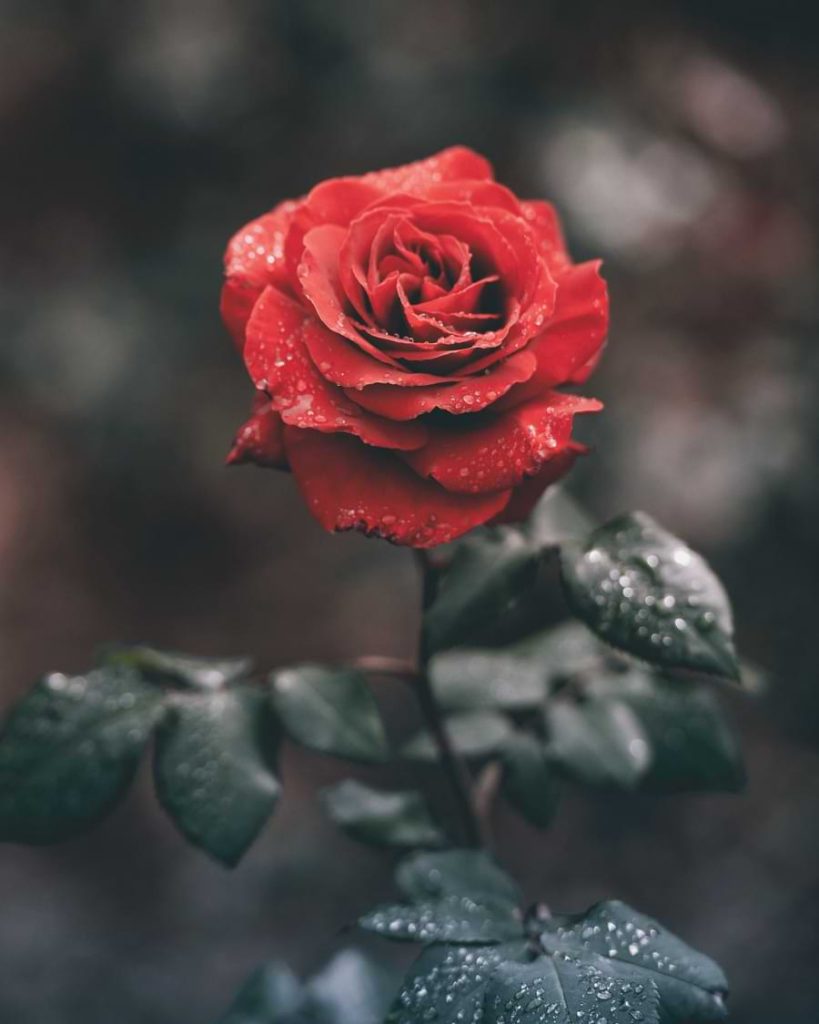
They have a classic teardrop shape, with a long stem and a large, solitary bloom. So they’re perfect for cutting and using in bouquets.
Like Grandiflora roses, Hybrid Tea roses are also repeated bloomers too. You can expect blooms in flushes throughout the growing season.
The blooms themselves are generally very fragrant, and the bushes are relatively disease-resistant. But like many rose types, they can be susceptible to blackspot and mildew, so regular spraying and care are important.
Like most roses, hybrid tea roses like at least 6 hours of sunlight. And in terms of hardiness, they can be grown quite easily in zones 5-9.
Hybrid Tea Rose – Main Characteristics
- Type: Modern Garden Rose
- Bush size: 2 – 8 feet
- Flower size: 3 – 5 inches across
- Petal Number: Up to 60
- Flower color: Classic red rose to yellow, pink, white, and deep crimson.
- Flowering: Repeating blooms throughout the growing season
- Stem: Dark green stems and leaves, tall, some grown as thornless
- Fragrance: Strong and pleasant
- Disease Resistance: Moderately resistant to most diseases
- Hardiness: Ideal for zones 5-9
If you’re looking for the classic rose to grow, that is reasonably hardy and produces flowers you can cut for arrangements, the Hybrid Tea rose is the one for you. To me, it’s the signature rose!
If The Hybrid tea rose sounds like the classic rose for you, then go over to shop a range of hybrid tea roses.
For a full rundown on Hybrid tea roses, see my article outlining much more about Hybrid tea roses for more info, characteristics, uses, and care.
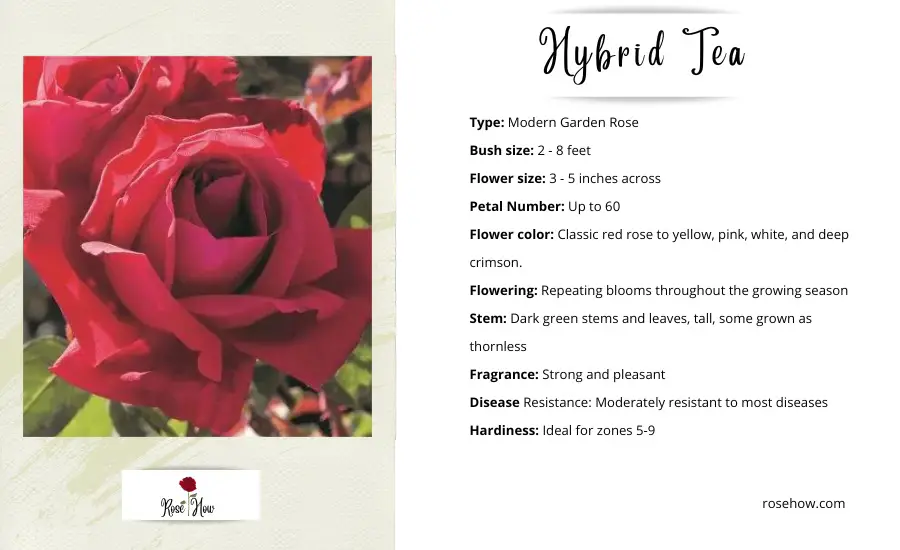
Those three types are almost certainly the most popular. Less popular, but equally as beautiful are Polyantha roses. Let’s move on to those next…
Polyantha Roses
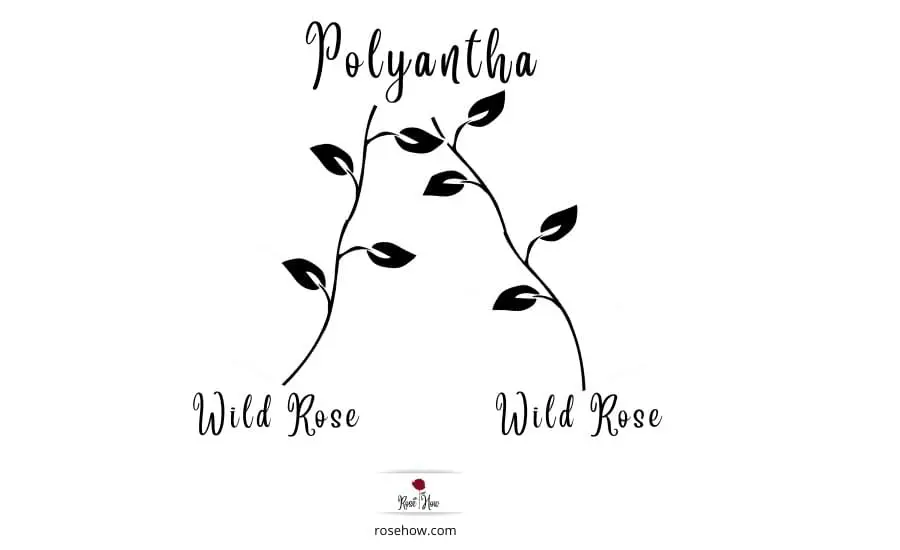
Polyantha roses are a type of old garden rose that was popular in the early 20th century. They’re known for their small, but very abundant flowers.
They tend to bloom in clusters and are available in a wide range of colors including white, pink, yellow, and red.
They range in size between 2 and 4 feet tall, and the roses are around 2 inches across.
Polyantha roses are often used as groundcover roses, or in hedges, as they are dense, compact shrubs with small leaves and clusters of small flowers.
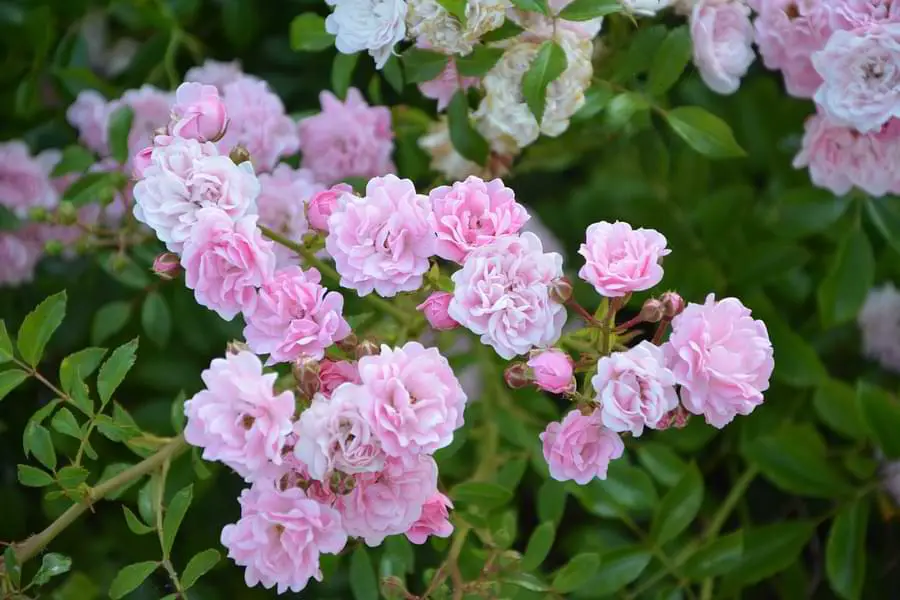
While they’re usually classified as “groundcover roses”, there are also some climbing varieties available.
They tend to bloom in the spring and through summer and can re-bloom if the dead flowers are removed.
In terms of climate and hardiness, they are ideal to grow in zones 5-9, but some can grow in zone 4. This type of rose is incredibly easy to care for and is also resistant to many types of diseases.
Polyantha Rose – Main Characteristics
- Type: Old Garden Rose
- Bush size: 2 – 4 feet tall
- Flower size: 2 inches across
- Petal Number: Up to 25
- Flower color: Wide range of colors including white, pink, yellow, and red.
- Flowering: Clusters, Blooms in Spring and often through the Summer
- Stem: Small leaves, and a compact spread
- Fragrance: Average fragrance
- Disease Resistance: Good resistance to diseases
- Hardiness: Ideal for zones 5-9, some varieties suit zone 4
If you’re looking for a small to medium size rose …with small flowers and one that will give you an abundance of flowers, with very little effort on your part, then the polyantha rose is a great choice!
The compact size of the polyantha bush makes it perfect for growing in smaller gardens, or even in pots and containers on a patio or balcony.
The most popular polyantha rose is probably the ‘The Fairy’ rose, which was introduced in 1932. This variety only grows to about 2 feet tall and has double pink flowers that bloom bright pink roses from early Spring right through to the first frost.
Check out my article on Polyantha roses, info, characteristics, uses, and care.
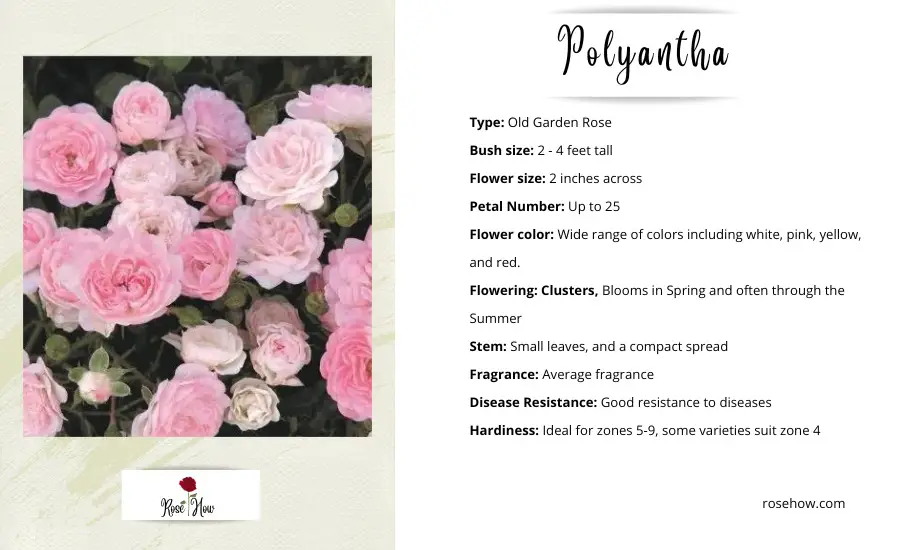
Miniature and Miniflora Roses
Next in our types of roses article, we have Miniature Roses and Miniflora Roses…
Miniature Roses
Miniature roses are a type of rose that as the name suggests, is much smaller than other types of roses.
They are a cross between hybrid tea roses and polyantha roses. This is the same as Floribundas, the main distinction is simply in the size.
They were first bred in the 19th century and were very popular in the 20th century as they could be used in rose beds, borders, and even as potted plants.
Miniature roses usually only grow to be about 2 feet tall with smaller leaves and flowers.
They come in a wide range of colors including white, yellow, pink, and red. The number of petals and size of the flowers are usually based on which class they are in.
For hardiness, they are somewhere in the middle. They can tolerate some of the cold but not too much. So ideally they need to be grown in zones 6-10.
In terms of being disease resistant, this is a difficult question to answer as there are so many types and hybrids of miniature roses. Some types are more disease resistant than others. Overall, however, miniature roses are generally quite a disease-resistant type.
Here’s some further reading on Miniature roses.
Can Miniature Roses Be Planted Outside? A Helpful Guide
Best Soil for Miniature Roses: Mini Roses, in Beds and Pots
Aphids on Miniature Roses: The Types, and How to Tackle Them
Miniflora Roses
Miniflora roses are a type of rose that was developed in the 1970s. They are a cross between a miniature rose and a floribunda rose and are intermediate in size between the two.
Miniflora roses usually grow to be about 3 feet tall and have larger flowers and a more upright growth habit than miniature roses.
Miniflora roses come in a wide range of colors including white, yellow, pink, red, and even purple.
They are a popular type of rose for use in gardens, landscape plants, and as cut flowers. They’re ideal for growing in pots and containers too, so are good for patios.
Miniflora roses are generally more disease-resistant than other types of roses, but they can still be susceptible to black spot disease, and powdery mildew.
Here’s some further reading on Miniflora roses.
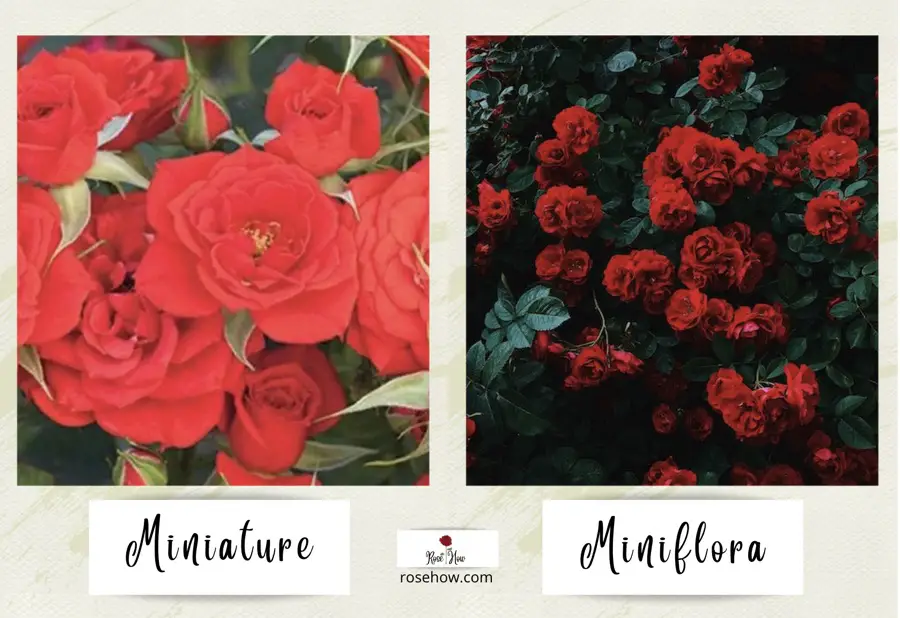
Shrub Roses
Most shrub roses are hybrids that have been developed to combine the best characteristics of both old garden roses and modern roses.
Shrub roses are usually very hardy and disease-resistant, and they come in a wide range of colors including white, yellow, pink, red, and purple.
They can range in size from 2 feet to 6 feet tall, depending on the type you plant.
Shrub roses are a type of rose that is characterized by their multi-stemmed, somewhat sprawling growth habit.
They are usually quite hardy and can tolerate some neglect. This makes them a good choice for gardeners who don’t want to spend a lot of time caring for their plants.
In terms of zones, they generally prefer zones 4-9.
Different types of shrub roses include
- Alba roses: These are one of the oldest types of roses, and they are characterized by their white or pale pink flowers.
- Bourbon roses: Named for the island of Bourbon (now known as Réunion), these roses are characterized by their large, fragrant flowers.
- Damask roses: These roses are characterized by their deep pink or purple flowers and strong, sweet scent.
- Gallica roses: Gallica roses are some of the oldest types of roses, and they are characterized by their small size and deep red or purple flowers.
One popular example of this type is Knockout roses, a type of shrub rose that is known for its easy-care nature.
They are resistant to many common rose diseases and they bloom continuously throughout the growing season.
Their flowers come in a variety of colors including pink, red, and white. yellow and peach.
All the roses on this list are knockout roses, I’d strongly recommend trying them.
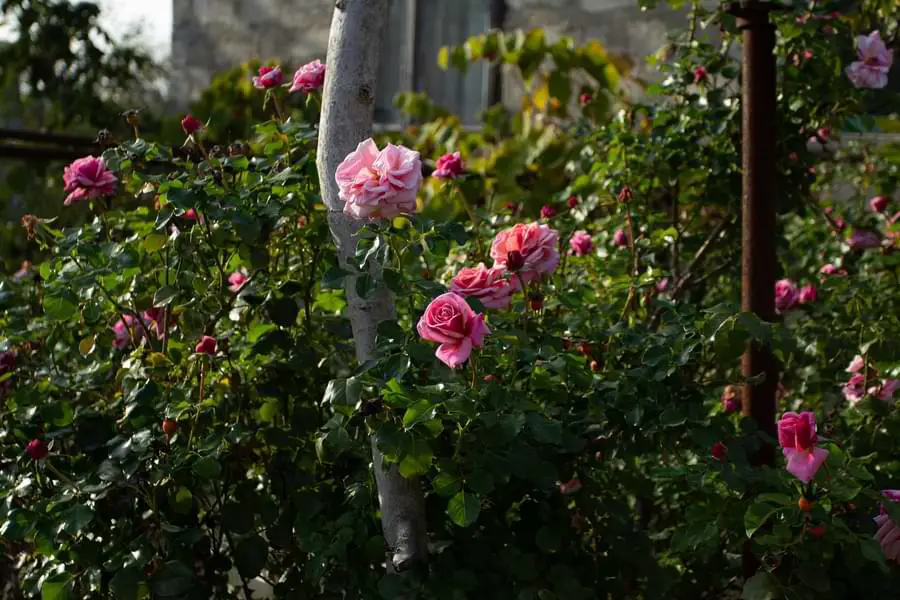
Climbing and Rambling Roses
Climbers and ramblers have a few key differences.
Climbing roses
The climbing rose is a type of rose that is grown on structures such as trellises, fences, or walls.
They are typically taller than other types of roses and can reach heights of 20 feet or more. Blooming is usually once per year and with single or double flowers.
They are different from rambling roses in that they have a more compact growth habit and their stems are not as flexible.
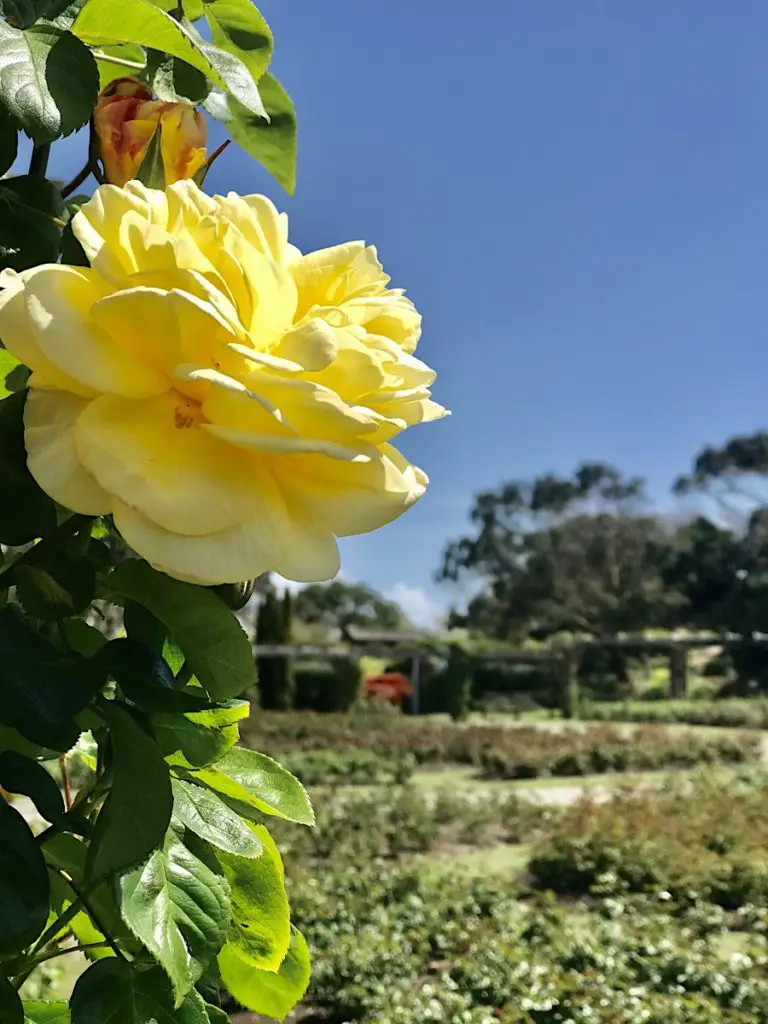
Rambling roses
Ramblers are a type of climbing rose that is characterized by its casual, sprawling growth habit. They also climb quicker than climber roses.
They can reach heights of 30 feet or more and their stems are very flexible, which allows them to wrap around structures.
Their flowers are typically smaller than those of climbing roses that appear in clusters rather than on single stems.
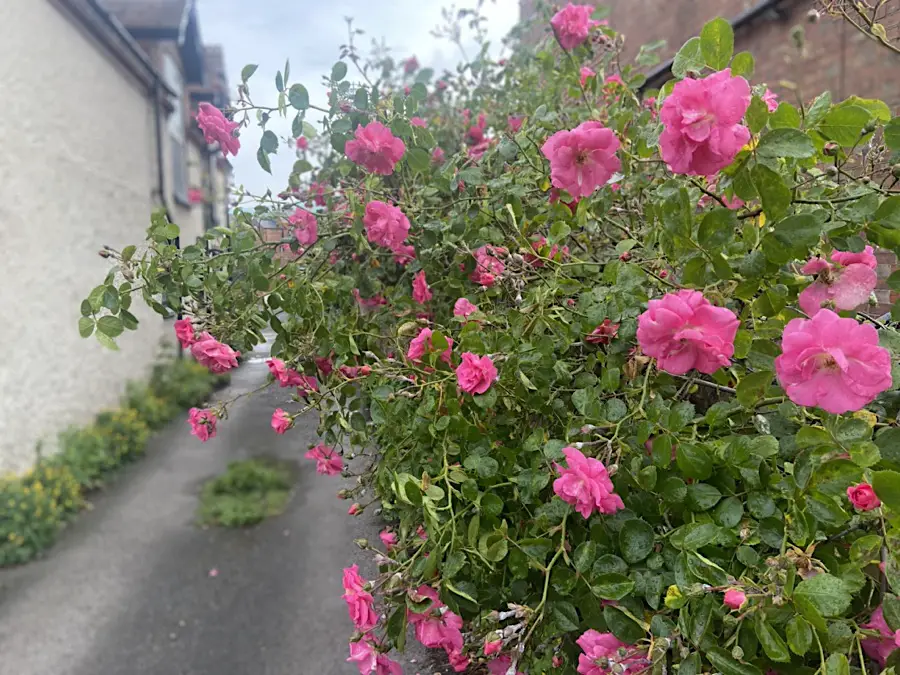
Here’s a quick summary of each…
| Climbing Roses | Rambler Roses |
|---|---|
| Measured growth | Intensive growth |
| Singular, large flowers | Sprays of small flowers |
| Often repeated blooms | Mostly one annual bloom |
Rose Trees
A rose tree – or Tree rose, is created by grafting a rose onto a stem that has been trained to grow vertically.
This gives the rose plant the appearance of a small tree. The tree is then usually a spray of flowers or fashioned into a circular shape to resemble a lollipop shape
The graft is usually done about 18 inches above the ground, which leaves about 2-3 feet of stem below the graft point.
Rose trees are usually quite expensive, but they are very lovely and will last for many years.
Sometimes they can be easily “manicured” in their looks, so they’re ideal for courtyards, porches, and patios. Also, great for small gardens since they don’t take up a lot of ground space.
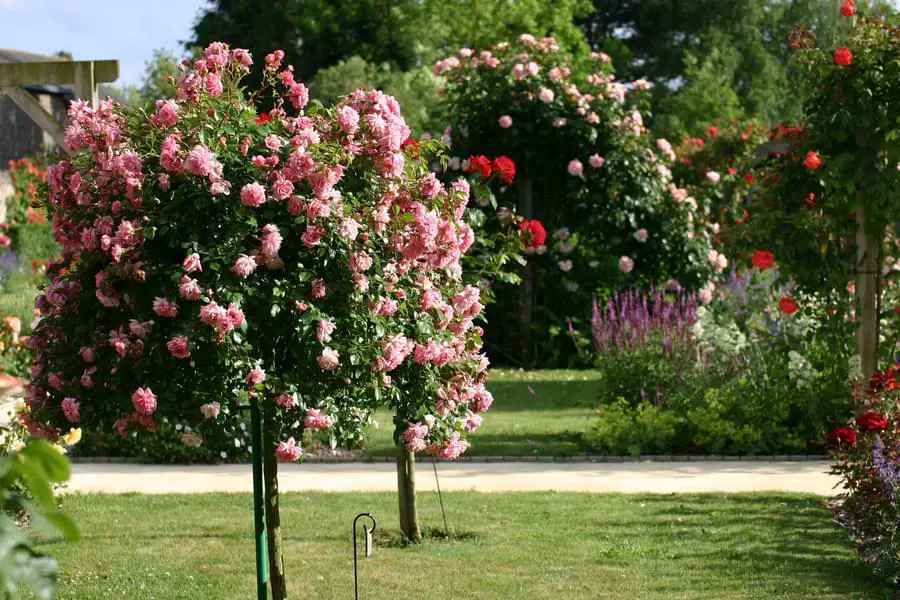
Types of roses ~ More roses help 🌹
So there you have it, my rundown on the types of roses you might come across.
There are many types of roses, and each one is special in its very own way. Whether you’re looking for a climbing rose to grow up your trellis or a shrub rose to add color and life to your garden, there’s a special rose out there for you.
Hopefully, now that you know the different types of roses, it will help you to decide which one is right for your garden!
As you can see, the delineation between types of roses, shrubs, or climbers can get quite complex, as shrubs and climbers, it seems, appear in all groups. So you’d be forgiven for being confused.
At the end of the head-scratching taxonomical process, it honestly doesn’t seem to matter. What matters is if you can glean a few key facts about each type and make a judgment as to whether it’s a good fit for your garden. That is at least what I do!
Take a look at my recommended tools and resources page. And be sure to check out my other related articles below…

Hi, I’m Michael. My passion for roses was sparked a few years ago after visiting a dedicated community rose garden. So Rosehow.com represents my take, my learnings, and my help for anyone looking to grow, be proud of, and harvest roses.

